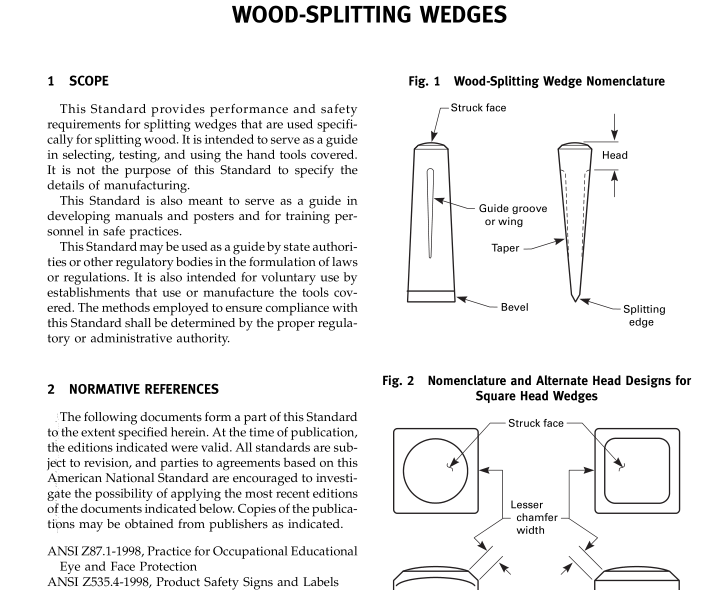ASME B107-410 pdf download

ASME B107-410 pdf download Struck Tools Incorporation of ASME B107.43, ASME B107.44, ASME B107.46, ASME B107.48, ASME B107.49, ASME B107.50, ASME B107.52, and ASME B107.59
4 REQUIREMENTS
4.1 Design Wood-splitting wedges shall have a splitting edge and taper for splitting wood, and a struck face to be struck by the appropriate striking tool. An appropriate striking tool shall mean a sledge or woodchopper’s maul with a striking face not less than 0.375 in. (9.50 mm) larger in diameter than the struck face of the wood-splitting wedge. Typical styles of wood-splitting wedges are shown in Figs. 1, 2, and 3, and their uses are listed below. The names are those generally recognized; however, styles are not limited to those named or illustrated.
(a) The struck face shall have a flat or convex shape. (b) The struck face of all wedges shall have a chamfer of approximately 45 deg (or equivalent radius) around the perimeter, with the lesser width equal to approxi- matelyone-tenthofthe minimumheadwidth. Forexam- ple, if the minimum head width equals 2 in. (50.8 mm), then the lesser chamfer width will equal approximately 0.2 in. (5 mm). (c) All wedges shall be free of nonfunctional sharp edges, points, and surface roughness that could inflict personal injury on the user when handling the tool. (d) Wedges shall pass the tests outlined in section 5.
4.2 Materials The materials used inthe manufacture ofwedges shall be such as to produce wedges conforming to the require- ments specified herein.
4.3 Mechanical Properties The hardness of the wood-splitting wedges shall not exceed 35 HRC or equivalent.
5 TESTS Many tests required herein are inherently hazardous, and adequate safeguards for personnel and property shall be employed in conducting such tests. Separate (new) wedges shall be used for each test. Failure to meet the requirements of either test indicates that the wedges do not comply with this Standard.
5.1 Hardness Determination Test Hardness determination shall be made on a fixtured wood-splitting wedge or on a mounted or unmounted specimen that has been cut from the tool using the wet abrasive or other equivalent method. Any hardness test will be acceptable that uses equipment and methods equivalent to Rockwell hardness determination as specified in ASTM E 18.
5.2 Struck Face Test The wedge shall be vertically mounted and supported with the splitting edge resisting directly on a mild steel plate of not less than 0.75 in. (19.1 mm) thickness. The steel plate shall be rigidly supported on an anvil or other similardevice ofsufficientmass to resistdeflection. Prior to conducting this test, care should be taken to blunt the splitting edge to ensure that the impact energy is not expended in deformation of the splitting edge. A steel weight of10 lb (4.5 kg) witha striking face hardness of 45 HRC to 60 HRC shall be dropped unrestricted from a heightof5.0 ft (1.5 m) onto the wedge a minimum of five times. Typically, the weight is cylindrical and is dropped through a seamless tube slightly larger than the diameter of the weight. The weight shall be dropped in such a manner that each drop applies the full force squarely to the struck face of the wedge. The struck face shall not crack or chip. Normal defor- mation of the struck face shall be permitted.
6 SAFETY REQUIREMENTS AND LIMITATIONS OF USE Instructors and employers shall stress proper and safe use of wedges and shall emphasize the need to wear and ensure the use of safety goggles. The publication Guide to Hand Tools —Selection, Safety Tips, ProperUse and Care provides guidelines for the safe use of these tools.
(a) Wood-splitting wedges are special-purpose tools designed and intended only for use in splitting wood.
(b) Wood-splitting wedges shall not be struck with an ax or hatchet.
(c) A blow from an appropriate striking tool shall be struck squarely, with the striking face parallel with a struck face of the wedge. Glancing blows, overstrikes, and understrikes should be avoided. An appropriate striking tool shall be a sledge or wood- chopper’s maul with a strikingface notless than0.375 in. (9.53 mm) larger in diameter than the struck face of the wood-splitting wedge.
(d) Safety goggles or equivalent eye protection con- forming to ANSI Z87.1 shall be worn by the user and









